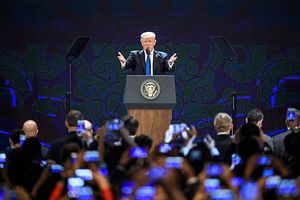Over the past few months, amid planned high-level engagements, there has been more talk about the potential of formally elevating the state of U.S.-Vietnam relations to the level of a strategic partnership in the future. While the idea itself is far from new, its implications deserve careful attention both with respect to bilateral ties themselves as well as wider regional and international developments.
U.S.-Vietnam relations have come quite far from where they were during the Vietnam War. While gradual normalization of ties took off during former President Bill Clinton’s term and continued with subsequent Democratic and Republican administrations, of particular note was the elevation of ties to the level of a comprehensive partnership in 2015 under then President Barack Obama. As I have noted previously here and elsewhere, this redesignation was significant for the policymaking communities of both countries: It reflected Washington’s efforts to expand its network of alliances and partnerships in the Asia-Pacific and Vietnam’s increasing importance within that network, along with other comprehensive partners such as Malaysia and Indonesia (which was later elevated to a strategic partner); and it also underscored the opportunities and challenges Hanoi has to weigh as it engages the United States within its own hierarchy of wider partnerships.
Amid a mix of notable firsts and new challenges under the Trump administration so far – with headline developments including a first U.S. aircraft carrier visit to Vietnam to scrutiny on the U.S.-Vietnam trade balance – there has been talk about the potential of elevating U.S.-Vietnam relations to a strategic partnership. This has occurred amid the planning for high-level engagements, most notably that of the potential U.S. visit of Vietnam’s communist party chief and president Nguyen Phu Trong following his first-ever voyage to Washington back in 2015: in and of itself a historic development for U.S.-Vietnam relations.
The chatter about the move is far from surprising. While the development itself may not be as dramatic as expected headlines may suggest – Indonesia, for instance, went through a similar process of forging a comprehensive partnership which was then elevated to a strategic partnership with the United States – it is not without significance. Given the historical legacy of U.S.-Vietnam relations and lingering contemporary differences on areas from regime type to human rights, an elevation of this sort would reinforce the growing strategic convergence between the two countries to each other as well as to their bureaucracies, publics, and other regional states. The designation could also have wider implications beyond bilateral ties itself in an environment of growing U.S.-China competition in the Asia-Pacific and Vietnam’s role in regional issues such as the South China Sea, where the trend of growing Chinese assertiveness and control has far from abated and Hanoi has come under increasing pressure.
But discussions about such a designation aren’t without their share of concerns. For one, the spotlight on issue-specific differences in U.S.-Vietnam relations over trade or North Korea in the past few years have at times made the relationship’s handling appear less comprehensive – let alone strategic – than the geopolitical realities that has been propelling it thus far would suggest. For another, the regional and international context has also increased the scrutiny on alignments forged, however loosely, between countries and either the United States or China, be it initiatives such as the Free and Open Indo-Pacific strategy, which saw its first outlines publicly articulated during Trump’s remarks at the APEC Summit in Vietnam in 2017, or reported new defense facilities. These factors matter because they will play into calculations that policymakers make about the costs and benefits of general alignment shifts as well as more specific aspects such as timing and messaging. It is no coincidence, for instance, that we have seen Vietnam hold off on some defense-related inroads with the United States in spite the gains that we have seen even as it also makes new inroads in other key relationships such as those with the European Union and Japan.
These concerns do not in of themselves mean that a U.S.-Vietnam strategic partnership is undesirable or unrealizable. Indeed, as mentioned at the outset, despite the ups and downs of bilateral ties, strategic trends as they are today are moving Washington and Hanoi towards greater alignment, not less, irrespective of the labels publicly used. But it does mean that that both the United States and Vietnam need to ensure that the realities of the relationship match whatever designation they choose to adopt when they choose to adopt it. Ultimately, alignment labels are only as worth as much as the commitment that both sides are willing to invest into translating potential convergence into realized cooperation, as evidenced by the mix of underperforming and overperforming alliances and partnerships in the Asia-Pacific region. The U.S.-Vietnam relationship is not immune from these considerations, and it will be judged relative to not just where it is today relative to the past, but where it could and should be given how much the two countries share irrespective of the differences that still exist between them.

































